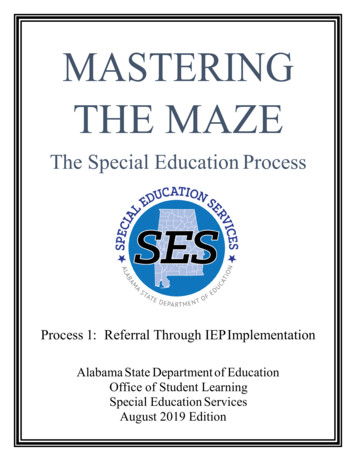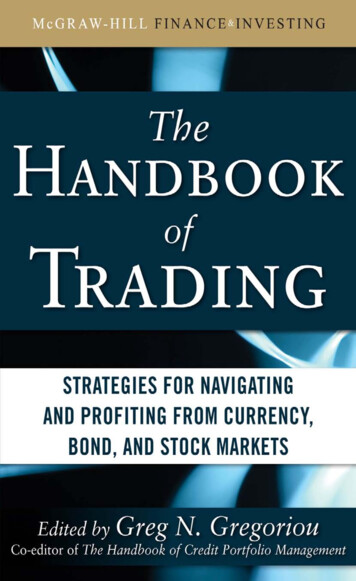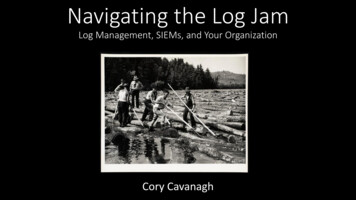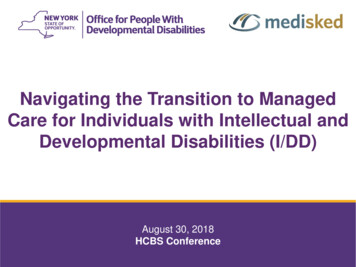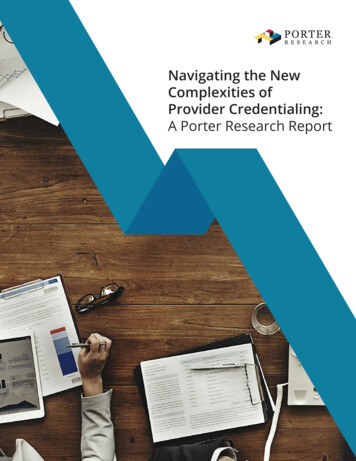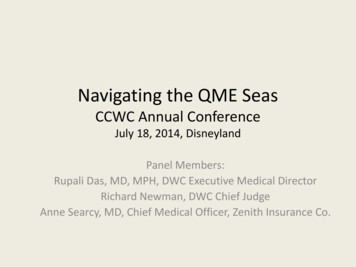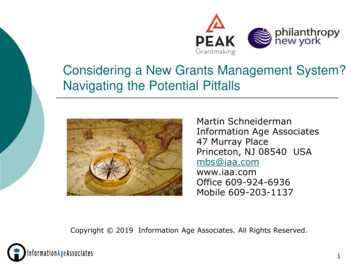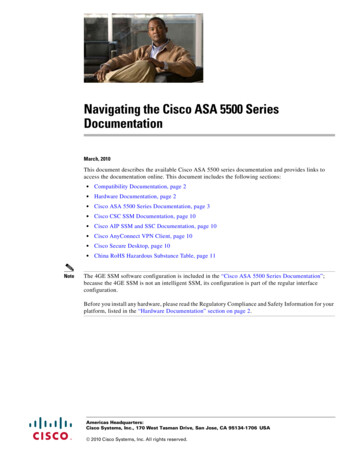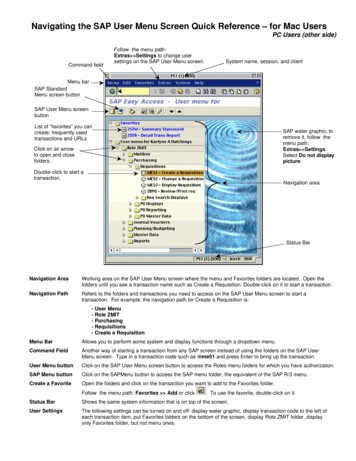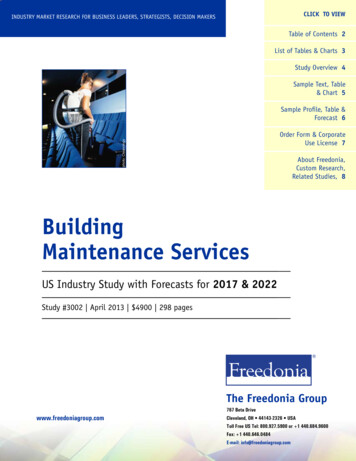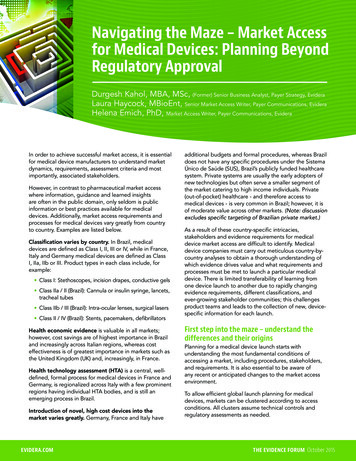
Transcription
Navigating the Maze – Market Accessfor Medical Devices: Planning BeyondRegulatory ApprovalDurgesh Kahol, MBA, MSc, (Former) Senior Business Analyst, Payer Strategy, EvideraLaura Haycock, MBioEnt, Senior Market Access Writer, Payer Communications, EvideraHelena Emich, PhD, Market Access Writer, Payer Communications, EvideraIn order to achieve successful market access, it is essentialfor medical device manufacturers to understand marketdynamics, requirements, assessment criteria and mostimportantly, associated stakeholders.However, in contrast to pharmaceutical market accesswhere information, guidance and learned insightsare often in the public domain, only seldom is publicinformation or best practices available for medicaldevices. Additionally, market access requirements andprocesses for medical devices vary greatly from countryto country. Examples are listed below.Classification varies by country. In Brazil, medicaldevices are defined as Class I, II, III or IV, while in France,Italy and Germany medical devices are defined as ClassI, IIa, IIb or III. Product types in each class include, forexample: Class I: Stethoscopes, incision drapes, conductive gels Class IIa / II (Brazil): Cannula or insulin syringe, lancets,tracheal tubes Class IIb / III (Brazil): Intra-ocular lenses, surgical lasers Class II / IV (Brazil): Stents, pacemakers, defibrillatorsHealth economic evidence is valuable in all markets;however, cost savings are of highest importance in Braziland increasingly across Italian regions, whereas costeffectiveness is of greatest importance in markets such asthe United Kingdom (UK) and, increasingly, in France.Health technology assessment (HTA) is a central, welldefined, formal process for medical devices in France andGermany, is regionalized across Italy with a few prominentregions having individual HTA bodies, and is still anemerging process in Brazil.Introduction of novel, high cost devices into themarket varies greatly. Germany, France and Italy haveEVIDERA.COMadditional budgets and formal procedures, whereas Brazildoes not have any specific procedures under the SistemaÚnico de Saúde (SUS), Brazil’s publicly funded healthcaresystem. Private systems are usually the early adopters ofnew technologies but often serve a smaller segment ofthe market catering to high income individuals. Private(out-of-pocket) healthcare - and therefore access tomedical devices - is very common in Brazil; however, it isof moderate value across other markets. (Note: discussionexcludes specific targeting of Brazilian private market.)As a result of these country-specific intricacies,stakeholders and evidence requirements for medicaldevice market access are difficult to identify. Medicaldevice companies must carry out meticulous country-bycountry analyses to obtain a thorough understanding ofwhich evidence drives value and what requirements andprocesses must be met to launch a particular medicaldevice. There is limited transferability of learning fromone device launch to another due to rapidly changingevidence requirements, different classifications, andever-growing stakeholder communities; this challengesproduct teams and leads to the collection of new, devicespecific information for each launch.First step into the maze – understand thedifferences and their originsPlanning for a medical device launch starts withunderstanding the most fundamental conditions ofaccessing a market, including procedures, stakeholders,and requirements. It is also essential to be aware ofany recent or anticipated changes to the market accessenvironment.To allow efficient global launch planning for medicaldevices, markets can be clustered according to accessconditions. All clusters assume technical controls andregulatory assessments as needed.THE EVIDENCE FORUM October 2015
Cluster 1: Market success depends on strength andreach of marketinghealth system (or innovation in some markets); requiresknowledge on what type of evidence is recognizedin different markets as valid for value demonstration;penetration of the market requires detailed marketingplanning as in Clusters 1 and 2Launch targets: Users (physicians or patients),purchasers (hospitals, physicians, nurses, wholesalers or/and pharmacists), and/or recipients (patients or familymembers of patients), depending on the deviceLaunch targets: All of Cluster 1 audiences, plusgovernment, semi-government or private agencies thatconduct value assessments; important launch targetsare national, regional, or budget holders and purchasinggroupsLaunch planning: Driven by marketing groundwork,including messaging, coalition with end-target users, andprice sensitivityPrice: Defined by market demand, price of comparatorproducts and discounts, available technology, andimprovements in overall benefitsCoverage: Largely out of pocket or copaymentsRequirements of manufacturer’s local team: Knowledgeof demand, target size, messaging and sales force needsExample markets: China, India, select markets in SouthAmerica and the Middle EastCluster 2: Market success depends on meetingpricing and reimbursement requirementsand marketingLaunch planning: Needs to meet local reimbursementconditions (e.g., medical devices of a particular class can/cannot be reimbursed) and price assessment or maximumprice fix; price and reimbursement opportunities aredriven by marketing and similar marketing planning as inCluster 1 appliesLaunch targets: All of Cluster 1 audiences, plusgovernment, semi-government, or private agencies thatregulate reimbursement or price, often associated withpurchasingPrice: Price must balance the affordability versus theinnovation premium; generic devices need to considerthe price of comparator productsCoverage: In some markets, all eligible medical devicesare covered independent of class; in other markets,coverage is only for Class I-IIb devices; significant out-ofpocket or copaymentsRequirements of manufacturer’s local team: Expertisein reimbursement, price negotiations, and localrequirements. Knowledge of demand, target size,messaging, and sales force needsExample markets: Russia, Brazil, select Central EasternEuropean marketsCluster 3: Market success depends ondemonstrating valueLaunch planning: Needs to be based on providingscientific evidence which demonstrates the value ofthe medical device to patients, caregivers, and theEVIDERA.COMPrice: Pricing depends on level of demonstrated value(level of innovation in some markets), comparatorproducts price, and either mandatory or negotiateddiscountsCoverage: Depends on co-pay regulations per marketand prescription requirements (e.g., copayments aremore common across France and Italy than in Germany,especially true for devices of Class I to IIaRequirements of manufacturer’s local team: Expertisein scientific and health economic value demonstration,knowledge of reimbursement and price negotiations andlocal requirements; knowledge of demand, target size,messaging, sales force needs, purchasing requirements,and fund holdingExample markets: European Union (EU), United States(U.S.), Canada and AustraliaThe prescriptiveness of clusters and thefactor of timeThe use of clusters allows for recognition of the basicinformation and formulation of a plan, includinganticipated timing of execution and planning ofresources. It is important to obtain this information earlyin the planning phase in order to calculate the benefits/risks of different routes and allow for any missinginformation to be obtained.However, country access systems for medical devicesdevelop fast. The natural progression is for marketsto transition from Cluster 1 to Cluster 2 and 3, whilemarkets rarely shift in the opposite direction. Therefore,over time, markets are likely to increase their demands,requirements for access, and number of stakeholdersinvolved. As a result, more health technology skills inmedical device companies are required. Clustering allowsthe monitoring of requirements by market attributes andcan help to anticipate future changes to requirements,although country-specific differences should also beconsidered.Limitations of clustering and transparencyMost of the critical requirements for medical devicemarket access planning for Clusters 2 and 3 are not wellTHE EVIDENCE FORUM October 2015
Figure 1: Model for Medical Device Market AccessKnowing and understanding the ever developing differences in conditions that shape the market accessdesideratum for medical devices across markets is imperative for access planningCluster 1Market success based on marketing- no formal access systemCluster 2Access based on meeting pricing andreimbursement requirements, with co-pay orout of pocketCluster 3Success based on demonstrated valueTREND over time toward Demanding, Transparent, Predictable business environmentAdolescent marketAccess to a market via marketing — share of voiceBRAZILGERMANY, ITALY, FRANCESophisticated marketAccess to a market via meeting HTArequirements — share of valuepublished or promoted by the relevant organizations. Thiscontrasts to the pharmaceutical access pathways, whereprocesses, timelines, data requirements, and evidenceneeds are well communicated and stakeholders aregenerally easier to identify.Therefore, clustering is only a first step in creatingtransparency. Appropriate launch planning requiresadditional details to allow for a full assessment ofpreparation needs, investment, risks, and benefits. Thecritical differences between markets that were describedearlier often only transpire when individual markets areinvestigated in depth.Start with the End in Mind Per SWOT (strengths, weaknesses, opportunities,threats) assessment, identify the stakeholder actionpoints needed to ensure that the market accessprocess is well supported and accompanied by theappropriate communication of evidence for eachaudience3. An environment compendium allowing for theassessment of risks and identification of ways to managerisks. Components of the compendium should beadapted to the device, and include the following basicparameters - across device classes – to be investigatedfor a) timelines; b) processes; and c) strategic imperatives: Purchasing and distribution pathwaysTo allow for launch opportunity assessment, an earlycomparative definition of value and opportunity needs tobe conducted as outlined below. Funding and budget holding1. A value repository adapted to the device class andmarket requirements National/regional renegotiation of price Technical profile of the device and its value proposition, as well as identification of competitors and theirvalue propositions Summary of market access environment, including:a) Current funding and coding; b) Expected changesand challenges; and c) Price of current products (ifapplicable) Map assessment process in a specific market andassociated timelines2. Stakeholder mapping identifying level of relevanceand importance for the market access of the device(adapted to the device) Consider stakeholders: Market access assessment,budget decision makers, purchasers, and usersEVIDERA.COM Pricing, copays, and discounting4. Prospective influences that potentially offsetadditional planning imperatives, adapted to the device(the list below is non-exhaustive): External business environment: competitor developments and their potential positioning and request forfunding; changes in copayments or fees for service/use; new stakeholders and evidence requirements;new pathways to integrate medical devices in healthservice delivery (including push for homecare) Internal business capability: organization of responsesto address new evidence needsTable 1 highlights selected country-specific market accessinformation that is important for launch opportunityplanning and market access preparation of a device inCluster 2 and 3 markets.THE EVIDENCE FORUM October 2015
Table 1: Cross-Country Comparison of the Key Elements of Market Access for Medical Devices Based on Information Obtainedin 2014 and 2015ContextFRANCEGERMANYITALYBRAZIL S tatutory health insurance(Approx. 77% of healthcarespending is sourced fromthe public sector)2 Small percentage coveredunder private healthinsurance or competitivegovernmental schemes(only approx. 20%) Tax funded healthcare system. More Statutory health insurancethan 75% of device expenditureprovided to all (150 millioncovered by public healthcare system patients), a third of which (50million patients) also pay for The role of private healthprivate health insurance4insurance is very limited; in 2009,it accounted for only 1% of totalhealth spending3 Very fragmented, regionalizedsystem; regions have their ownHTA bodies (e.g., Lombardy, Vento);outcomes may differ by regions H GHMs (Diagnosis Related Groups eavyinvestments on[DRG])5medical devices GHS (DRG tariff)are concentratedin the hospitals G-DRG6 DRGs are nation-wide; however,regions can adapt tariffs and codesto some extentMechanismto supportinnovativedevices? PSTIC (Programme de soutien aux Rather thanroutine HTAtechniques innovantes, coûteusesprocesses,ou non)7additional routes PHRC (Le programme hospitalier deare availablerecherche clinique)7for early accessof innovativedevices Additional payments for high-cost, NUB (for devices notincluded in G-DRG; hospitalinnovative devices are regionallyspecific)6controlled; when regions publishthe updated DRG lists, there is a ZE (zusatzentgelte;section which specifies the devices/supplementary nationalprocedures for which an additionalpayments)6payment can be claimed. No specific mechanismsavailable to support innovativehigh-cost devices4 However, there is greateradaptability in the private sectoras HMOs (health maintenanceorganizations) need to becompetitive (i.e., private marketmechanisms); greater resistancein public sector on new/expensive device uptakeClassificationsystem D evices areclassified from aregulatory levelinto differentgrades based onlevel of risk andinvasivenessCE mark (Class I, IIa, IIb, III)5CE mark (Class I,
(Former) Senior Business Analyst, Payer Strategy, Evidera . Laura Haycock, MBioEnt, Senior Market Access Writer, Payer Communications, Evidera . Helena Emich, PhD, Market Access Writer, Payer Communications, Evidera. In order to achieve successful market access, it is essential . for medical device manufacturers to understand market
